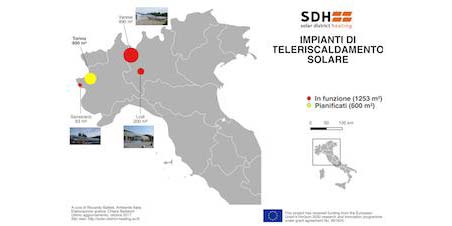Three installed systems and one more planned: SDH shows a few examples of operation in Italy but quite good perspectives thanks to relevant incentives and the recent inclusion in the National Energy Strategy for 2030. A workshop in Venice on 15 December 2017 will analyze the status quo and the possible developments.
Plants in operation and plans for the near future
As shown in the map below, three SDH plants are in operation at the moment in Italy. The first SDH plant has been installed in 2015 for feeding in the district heating network of Varese: 990 m² of flat plate solar collectors are used for pre-heating either the make-up water or the return line of the network. Operational results for the first year show a very good performance, with a +13 % over the expected design yield.
The second system, commissioned in 2016, has a much smaller size, with a total gross area of 63 m², and combines solar thermal with a gas-fired CHP unit for a local district heating network located in the mountain village of Sansicario, in the province of Turin. The peculiarities of this plant are the use of two different technologies, flat plate collectors and evacuated tubes, and the opportunity to test solar thermal operation at 1 600 meters above sea level.
The last example is a 200 m² solar plant connected to the district heating network of the city of Lodi in 2017. This is a case of ‘third-party access’ since the whole solar thermal production is injected into the grid and is purchased by the DH utility from the owner of the solar thermal system. Besides these installed systems, the utility Gruppo Iren has planned to install a 600 m² SDH system for its DH network in Turin by 2020.
Incentives and policies: Good perspectives
The national incentive of Conto Termico 2.0 supports energy efficiency measures and small renewable heat systems, including solar thermal plants, also for district heating applications, up to 2 500 m² gross area. The amount of the incentive, paid in five annual instalments, depends on the system size, the application and the expected collector yield. For SDH plants, this amount can range between 40 % and 60 % of the investment cost.
Furthermore, budgetary resources for this scheme are quite generous, corresponding to a yearly amount of 200 million EUR for public bodies and 700 million EUR for private subjects, and a larger portion of these resources are still available.
From a policy point of view, it is worth to mention that, thanks to a consultation comment sent by Ambiente Italia on behalf of the SDHp2m project, the National Energy Strategy, released by the Italian Government in November 2017, explicitly includes solar district heating as a viable option to ‘reduce installation and O&M costs’ and ‘particularly interesting for smart and flexible district heating network, where multiple energy sources are operating together’.
A workshop in Venice
On 15 December 2017, Ambiente Italia organized, in collaboration with the Veneto Region, a specific workshop on the use of solar thermal in combination with other renewables, especially biomass, for supplying thermal energy through small local DH grids.
More information on the event is available here.
